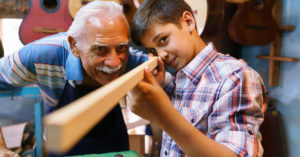
When we were in 7th grade, it was not uncommon to be working on projects and assignments that seemed useless at the time. But little did we know, how much those assignments were teaching us how to handle the problems we would face as adults.
The Class: Wood Shop
It was my favorite class of the day: wood shop. This was my favorite class because I had the class together with Ricky and Dan, my two best friends at the time. My 7th-grade teacher was someone I looked up to, but I could not say the same about him. The teacher was often frustrated with my friends and I because we were not necessarily the best and the brightest, nor the most mature ones in the class. Nevertheless, we managed to team up for the contest that was assigned that day.
The Contest: Build a Bridge
Our teacher broke us into teams of three, and he gave us the assignment to build a bridge. The goal was to build a bridge that could withstand weight pressing down on it, without breaking it. The only things we were allowed to use were thin flimsy wooden sticks and Elmer’s wood glue to hold the bridge together. He did not provide any guidance and simply instructed us to use our imagination!
The Results: Not as the Teacher Expected
At the end of the class, all the students gathered around to test all the bridges. You could very easily tell which bridges were made by the stars of the class; one set of girls had a bridge that looked like a model for an engineering project. Our bridge? It looked like a pile of sticks that had been through many cold winters. One by one, we started testing the bridges by adding weights in 5-pound increments onto the bridge. All our classmate’s bridges would collapse around 25 pounds or less. Our bridge? It took all of the available weights (300 pounds!) and did not break until the teacher physically pushed down on the bridge!
Why We Won
Ricky, Dan, and I were not out to make it look anything like a pretty bridge; we set out to make it carry weight. We were not engineers; we were 7th graders with the logical mindset that the strongest tables had strong posts. Which is why we spent the majority of the class building beams as thick and sturdy as we could. It was these I-beams that kept our structure from collapsing.
How It Relates To Your Business
The beams were the fundamentals applied on a micro scale that work on a macro scale. The idea being that your business’ I-beams are the things that hold you up when the weight of the competition and natural forces in the market are pushing you down. Focus on the single most important values your business believes in and make it a part of everything you do. Never lose sight of your beams and always seek for ways to make them stronger!
About the Author

Keith Freeman
A dynamic thinker with a great sense of humor, Keith Freeman, MBA, is a Strategic Consultant offering unique solutions to transform healthcare organizations such as hospitals, hospice/palliative, home health, and home care, RCFE/assisted living and skilled nursing facilities and professional healthcare staffing services that support them.

